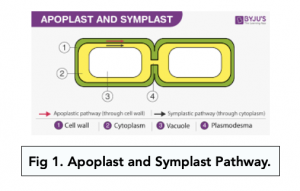The Pathway and Movement of Water into the Roots and Xylem (A-level Biology)
The Pathway and Movement of Water into the Roots and Xylem
Water movement
In the Root
- Water is a transport system. Water is essential in plants as it it used as a transport system for nutrients and minerals across a water potential gradient.
- Water potential is higher within the soil than the root hair cell. Water is taken up by the roots of a plant and through the endodermis, before being moved into xylem tissue, which is in the centre of the root. The water potential inside the soil is higher than that of that root hair cells. This is because of the dissolved substances in the cell sap.
- Root hair cells increase surface area. Root hair cells function to increase the surface area in order to be pumped across against the concentration gradient.
Water can reach the cortex of the xylem vessels via two pathways:
- Symplast, where water moves between the cytoplasm of neighbouring cells.
- Apoplast, where water can moves directly through the permeable cell walls and intercellular spaces of neighbouring cells.
The symplast pathway allows water to enter the cytoplasm via the plasma membrane, where it travels between cells through plasmodesmata.
Plasmodesmata are tiny channels which cross the cell walls of neighbouring plant cells in order to be able to connect their cytoplasm, creating a large multinucleate mass of plant cells.
The apoplast pathway doesn’t need to travel through the plasma membranes in order for the water to move through the spaces between the cellulose molecules. Because of this, it can carry dissolved mineral ions and salts.
Once the water reaches the endodermis of the root, a layer of suberin (known as the Casparian strip) stops the water’s path. This is because it cannot be penetrated by water.
To be able to cross the endodermis, the moving water can now use the symplast pathway by going down the water potential gradient to reach a pit in the xylem vessel. This is where water enters the vessel.

In the Xylem
Moving down the water potential gradient, water gets removed from the top of xylem vessel into mesophyll cells.
Root pressure, where the endodermis uses active transport to move minerals into the xylem, pushes the water upwards, into the xylem by osmosis.
Cohesion-Tension Theory
The cohesion-tension theory explains how water moves up the xylem.
- Water evaporates from the mesophyll cells within the leaf. This is known as transpiration, which is the evaporation of water from a plant.
- As water molecules are cohesive, tension is created. Water molecules stick together because the molecules can form hydrogen bonds with one another.
- This cohesion and tension causes more water to be drawn up into the xylem. The water is pulled up through the xylem via osmosis so that the vessel is filled with an uninterrupted column of water. This column will make its way up through the xylem until it evaporates from the mesophyll cell’s walls. The water then diffuses from air sacs in the leaf, through open stoma.
Cohesion is the attraction of same molecules. Hydrogen bonds are formed between water molecules.
Adhesion is the attraction of unlike molecules. Hydrogen bonds are formed between water and surfaces. An example of a surface used in adhesion it the pores in mesophyll cells.
Water moves into plants through the roots and into the xylem, which is responsible for transporting water and dissolved minerals from the roots to the rest of the plant.
Water moves into the roots of a plant through osmosis, which is the movement of water molecules from an area of high concentration to an area of low concentration. In the case of plants, water moves from the soil into the roots due to a lower concentration of water inside the roots.
Transpiration is the process by which water is lost from the leaves of a plant through small pores called stomata. This water loss creates a negative pressure in the xylem that pulls water up from the roots and into the rest of the plant.
Root pressure is a natural force that results from the accumulation of water and minerals in the roots. This pressure helps to push water up into the xylem and into the rest of the plant.
The structure of the xylem plays a critical role in the movement of water into plants. The xylem is composed of long, narrow tubes that run from the roots to the leaves, and the continuous column of water in the xylem is maintained by the cohesive forces of the water molecules.
Capillarity is the process by which water is drawn up into small tubes, such as the xylem in plants. The combination of capillarity and transpiration creates a continuous column of water in the xylem, which provides a pathway for water to move from the roots to the leaves.
The pathway and movement of water into plants is a critical concept for A-Level Biology students to understand because it highlights the interconnectedness of different plant structures and functions. Additionally, this knowledge provides a foundation for further studies in botany, plant physiology, and related fields.






Still got a question? Leave a comment
Leave a comment